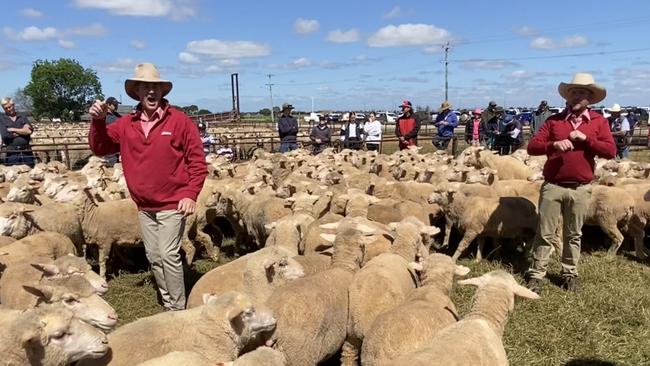Farmers take aim at forecasts as El Nino strips millions from markets
El Nino forecasts are causing “panic-selling” among livestock markets, with producers swamping markets.
Hype around predictions of El Nino could have cost the livestock industry tens of millions of dollars as producers swamp markets on the forecasts of a dry spring.
And while good rain fell across many areas of southern Australia last week, the Bureau of Meteorology is holding firm to its predictions of a drier-than-average spring ahead.
Rain that fell last week was cold comfort to those who had already sold prime and store stock and even genetics, as rates tumbled across the board. Despite falls of 40-100mm across parts of northern Victoria, the North East and Gippsland, it was not enough to counter negativity at store markets last week. Angus heifers sold down to $300 at Wodonga and at Jerilderie’s annual feature store sheep sale a third of the young ewe yarding made $100 or less.

A climate of fear is overshadowing the industry and driving the whole market, according to Elders national livestock manager Peter Homann.
“We hear El Nino and people think the whole of Australia is going to turn into the Great Sandy Desert,” Mr Homann said.
“In my job. I see a lot of Australia and there is a big, dry band in southern Queensland and northern and western NSW.
“But the rest of Australia is in pretty good nick, so why are people panic-selling in Leongatha or North East Victoria?”
Mr Homann said El Nino was almost always brought up in conversations he had, and “you cannot turn on the radio without hearing it”. “Producers are panic-selling and the whole industry is being driven by fear of El Nino,” he said.
Bureau of Meteorology climate manager Karl Braganza said El Nino did not mean that there would be no rain at all, and “we will see individual rain events” like those that happened across much of southeast Australia last week.
“But we can’t just look at one rain event. September rainfall was the lowest since the Federation drought,” Dr Braganza said.
But he acknowledged that education was needed to allow farmers to use seasonal outlooks and El Nino predictions as a risk-management tool.
And Dr Braganza said not all El Ninos led to drought or severe drought.
“I don’t encourage anyone to be frightened by a weather forecast,” Dr Braganza said.
“It is all about managing risk and doing that in an as even-headed manner as possible.
“That can mean some difficult decisions around water allocations and water markets, destocking, whether you sow or don’t sow.
“We encourage people to basically understand the forecast as well as possible and take a long-term risk management approach.”

Farmers who spoke to The Weekly Times said their incomes had been directly affected by talk of El Nino, even if their own seasons were strong.
Graeme Wilson, who runs the Kismet White Suffolk and Poll Dorset stud at Howlong, NSW, said clients at his sale last week told him they did not need as many rams because they were worried about El Nino.
He also attributed the drop in livestock prices to the surge of stock coming on to the market as people looked to offload numbers before the predicted dry conditions.
“I’ve heard quite a few times that people are selling because of the season and it’s causing a log jam at the abattoirs,” Mr Wilson said.
“It’s frustrating because people talk about El Nino but here, we have clover a foot high and have had a great winter with good feed all the way through.
“If it turns out not to be the case (that rainfall is average), then it will have cost the industry a fair bit of money, and cost us too in lost ram sales.”
Hexham farmer Lachie Kelly measured 14mm of rain last week and said while it was not as much as some areas, was still “very handy”. He said El Nino forecasts had affected the sentiment around livestock, with both sheep and cattle producers unwilling to restock.
“Everyone seems to be really cautious because of the El Nino talk, but it’s not the only factor,” Mr Kelly said.
“There are also those who are holding back because they were burnt badly trading stock in the past year with the fall in prices.”
In central Victoria, Marnoo sheep producer Ben Duxson said El Nino predictions did influence the way livestock producers thought about selling patterns.
“There does seem to have been a lot of media hype around El Nino this time and perhaps that has influenced producers too much,” Mr Duxson said.
“If we do get a dry summer, then that’s what we expect and that can be good for sheep producers who could be battling worms or other diseases.”
At Jerilderie last week, Merino breeder Ross Wells from Willandra was frustrated that talk of El Nino had taken the shine off ewe prices.
“I really feel the prices we’ve seen, which are so much lower, are based on the weather forecasts of El Nino,” Mr Wells said.
“We are not bad here and it seems most places are pretty good in the south.
“But everyone is just frightened of a dry season,” Mr Wells said.




